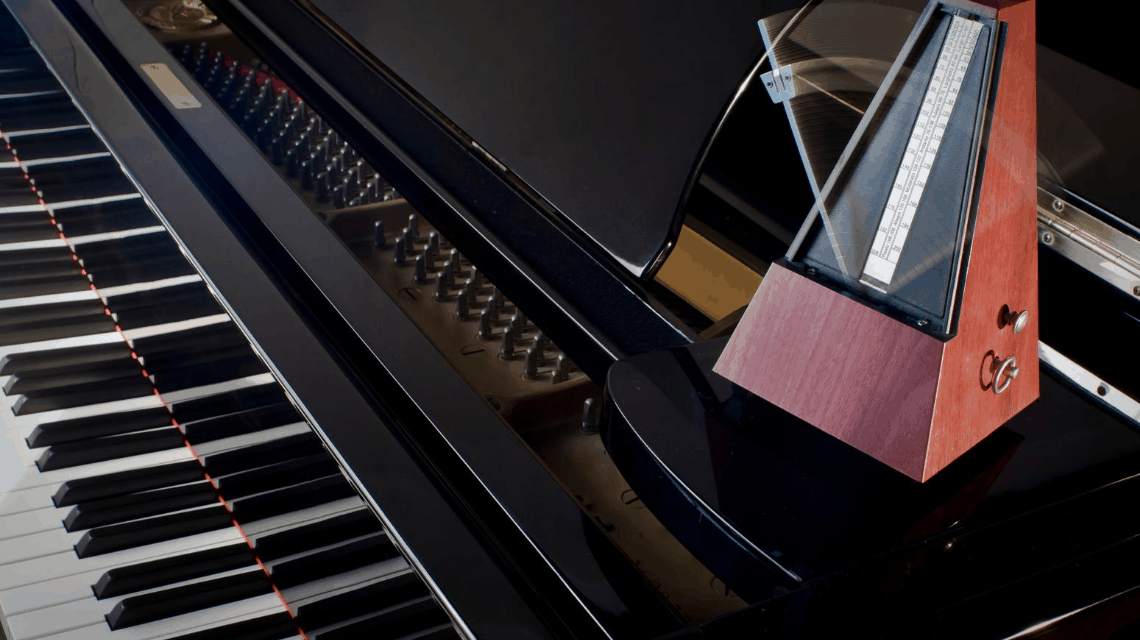How To Improve Your Piano Technique So You Can Play Faster
Check out these three tips if you're hoping to play faster!

Have you ever watched a virtuosic piano performance and wished that your hands could effortlessly whisk around the keys like that? Playing fast piano music is invigorating and exciting.
Some pianists make it look easy to play fast music. But, in reality, they have probably spent years building a strong technical foundation. They’ve probably put many hours of practice into getting that particular piece up to tempo.
If you feel like your piano music is dragging or if you’ve wished that you could play the piano with that stunning, polished finesse that you see from other pianists, don’t worry! You can learn how to play fast.
However, the way to achieve clean, fast piano technique might surprise you. And, it’s probably not what you want to hear:
Fast playing requires a lot of slow practice.
In fact, in order to play a fast piece of music, nearly all of your practice will take place at a much slower tempo.
It may seem counterintuitive. Some people assume that if you want to play fast music that it would make sense to spend a lot of time practicing at a fast tempo.
However, if you can’t play something well slowly, you can’t play it well fast either. Therefore, much of your practice will take place while focusing on slow, precise playing.
It will only be when you’re in the polishing stages of practice that you’ll want to be playing up to tempo. Even then, you’ll want to frequently revert back to slower practice to maintain control and to keep your music sounding crisp and clear.
If you’re working to accelerate your music, try these three things:
Focus on slow, deliberate practice
You have probably heard the saying, “Practice makes perfect.” In order to get better at playing the piano, the answer is to practice correctly, every single time. This means playing the fast passages way under tempo when you begin.Make sure that you canfocus onall of the details of your music at a slow tempo.
- Are you playing all of the correct notes?
- Are you playing with the correct fingerings?
- Are you leaving any notes out?
- Are your rhythms precise?
- Are you paying attention to expression markings?
- Are you playing with dynamic variation?
- Are you phrasing and playing with nice musicality?
Once you feel comfortable with all of these components of your practice, make sure that you can play large sections of your music slowly with good continuity.
If your music is flowing and moving, even at a slow pace, you may be ready to start playing a little faster. Every once in a while, push your tempo a little to test it out at a faster speed. If it feels messy or imprecise, slow back down and work through the trouble spots carefully. As you do move faster, increase your tempo little by little. Don’t go too fast too soon.
Maintain control but stay relaxed
One of the biggest issues that arises as pianists try to increase tempo is that their hands and body tense up. The tension can be heard in your music and can also lead to pain, discomfort or fatigue.
Unfortunately, many pianists develop injuries by holding on to too much tension while they are playing. This is very common but easy to avoid if you are mindful of it.
The challenge is that you have to maintain control over your music while keeping a relaxed posture and hand position.
Keep in mind that your body can be relaxed but engaged at the same time. You don’t want to have a limp or lazy posture at the piano, so find that perfect balance where you are engaged with good control over the keys but not holding tension.
Many pianists hold tension in their shoulders, which might work its way into the arms, wrists and hands. If you feel your shoulders creeping up towards your ears, lower them to their naturally relaxed position and feel the tension leaving your arms and hands.
It’s also common for pianists to hunch over at the piano, to sit too close to the keys or sit too far back on the piano bench. All of these things could lead to an achy back. If your back is uncomfortable while you are playing, it will be impossible to maintain a good posture and play with a clean technique.
See this post for more information on piano posture: “Piano Posture: Stay Injury Free with These Tip”
Use your metronome
Using the metronome is a sure way to increase your tempo as you are playing. It will also help you to maintain a steady beat, instead of slowing down and speeding up.
Taking a methodical approach with the metronome is a very efficient and effective way of increasing your tempo.
Here’s a good approach to using the metronome. Try this approach if you have already put in the time doing slow and deliberate practice, and you are starting to play your piece with continuity.
- Use the metronome to find your base tempo. This is where you can naturally play your music with good continuity and few mistakes. It’s okay if this tempo is half or even a quarter of your target tempo. You have to start somewhere!
- Play with the metronome at your base tempo until you can consistently play your music well at this tempo. This might happen in your first practice session, or you may spend many days or weeks establishing this starting point.
- Once you are confidently playing with the metronome at your base tempo, move the metronome up 2-4 beats per minute. Your music may not feel very different with this small of an increase.
- If you can play your music well at this slightly higher tempo marking, go ahead and move the metronome up another 2-4 beats per minute.
- If you reach a point where you are struggling to keep up with the metronome, take it back down to the last tempo that felt comfortable. Practice at that tempo a bit more before you try to increase it again.
- As you are ending a practice session, take note of the highest tempo marking that you reached. Next time you return to the piano, start at a tempo just under where you left off to warm up, then work your way back up to your highest tempo.
- Continue this process of increasing by 2-4 beats per minute until you arrive at your target tempo.
This whole process could take varying amounts of times. You might work through many different tempos in one practice session, or you may need to stay at one tempo for many practice sessions.
As you’re working towards playing your piano music, remember to have fun and enjoy the process! Yes, when you reach your targeted faster tempo, your music will be invigorating and life-giving. But, there are also many exciting moments along the way as it all comes together. Enjoy your practicing!
This post was written by Megan, piano teacher and author of Pianissimo: A Very Piano Blog. Visit her website for more piano related blogs for teachers, parents, students, and all things piano.
FAQ
- How long does it take to get better at piano? That depends upon how much you practice. If you are diligent and practice every day you will notice improvement each week.
- How many hours of piano should I practice each day? Ask your teacher. If you don’t have a teacher, one hour should be enough.
- Is piano the hardest instrument to master? All instruments have their tricky and difficult things. Piano isn’t necessarily more difficult than any other.
- How long do I spend on one piece each day? Spot practice the most difficult sections. A big mistake many pianists make is to practice their entire piece every day. Instead, make a note of the sections that are troubling you. Turn these into mini-practice sessions. Spend 15 to 20 minutes each day on very slow practice on just those few bars. At the end of the week reward yourself by playing the entire piece all the way through at a comfortable tempo.
- What are some methods of relieving tension? Yoga exercises are a great way to relieve tension. You can take a class in person or follow along with a video on the internet. Yoga stretches are also very good for your back. Many older pianists report having back pain from years of sitting on the bench. Introducing stretches into your routine now will have rewards down the road. Another excellent way performers of all kinds handle tension is through the Alexander Technique. You can take classes in this technique, visit practitioners of the technique, and also find all kinds of video aids on the internet. Our piano techniques can be physically demanding. Conscious relaxation efforts are the remedy.

